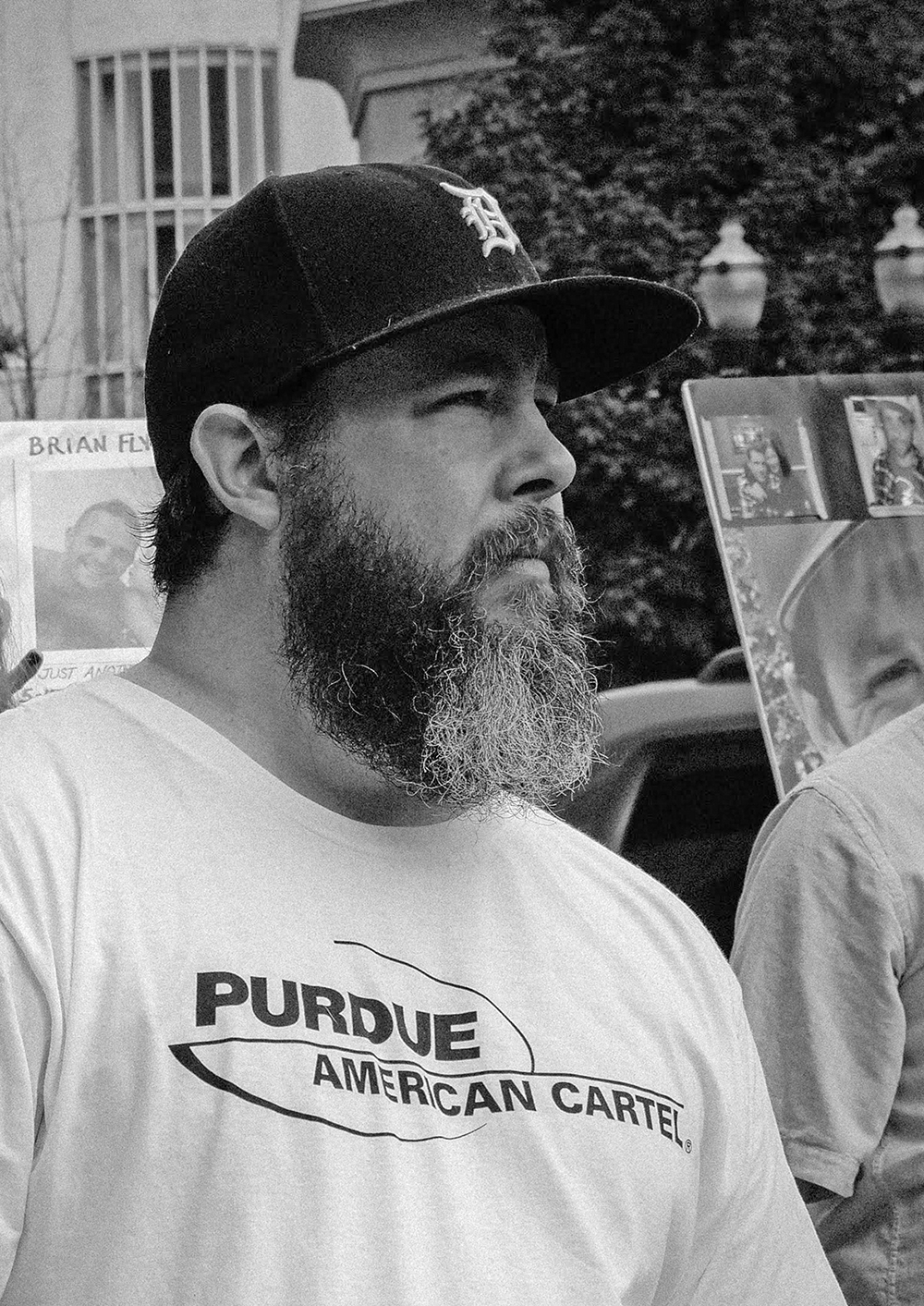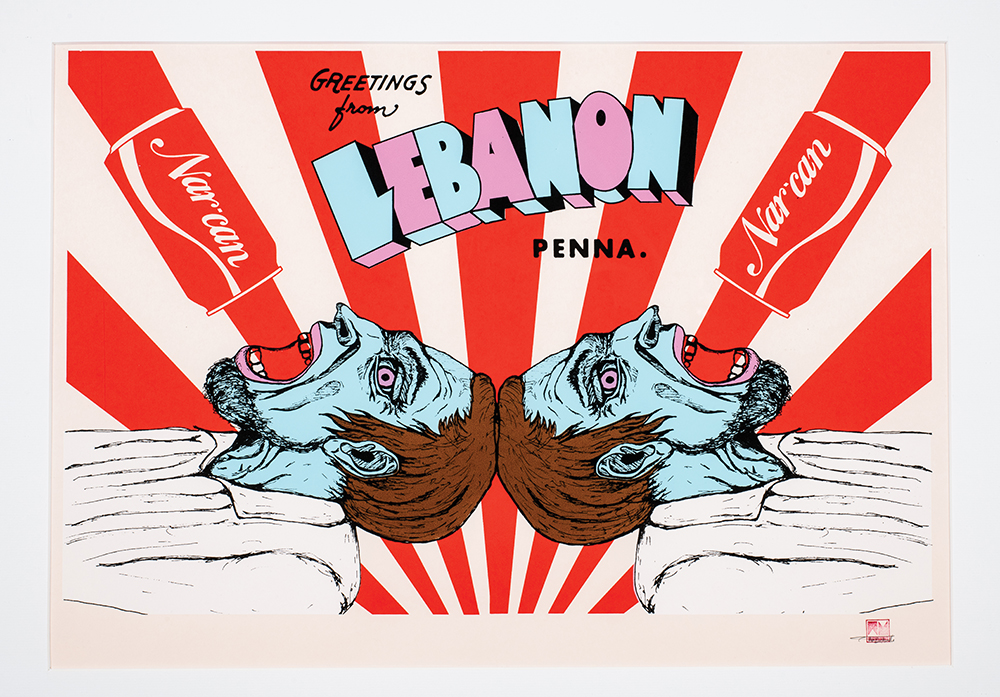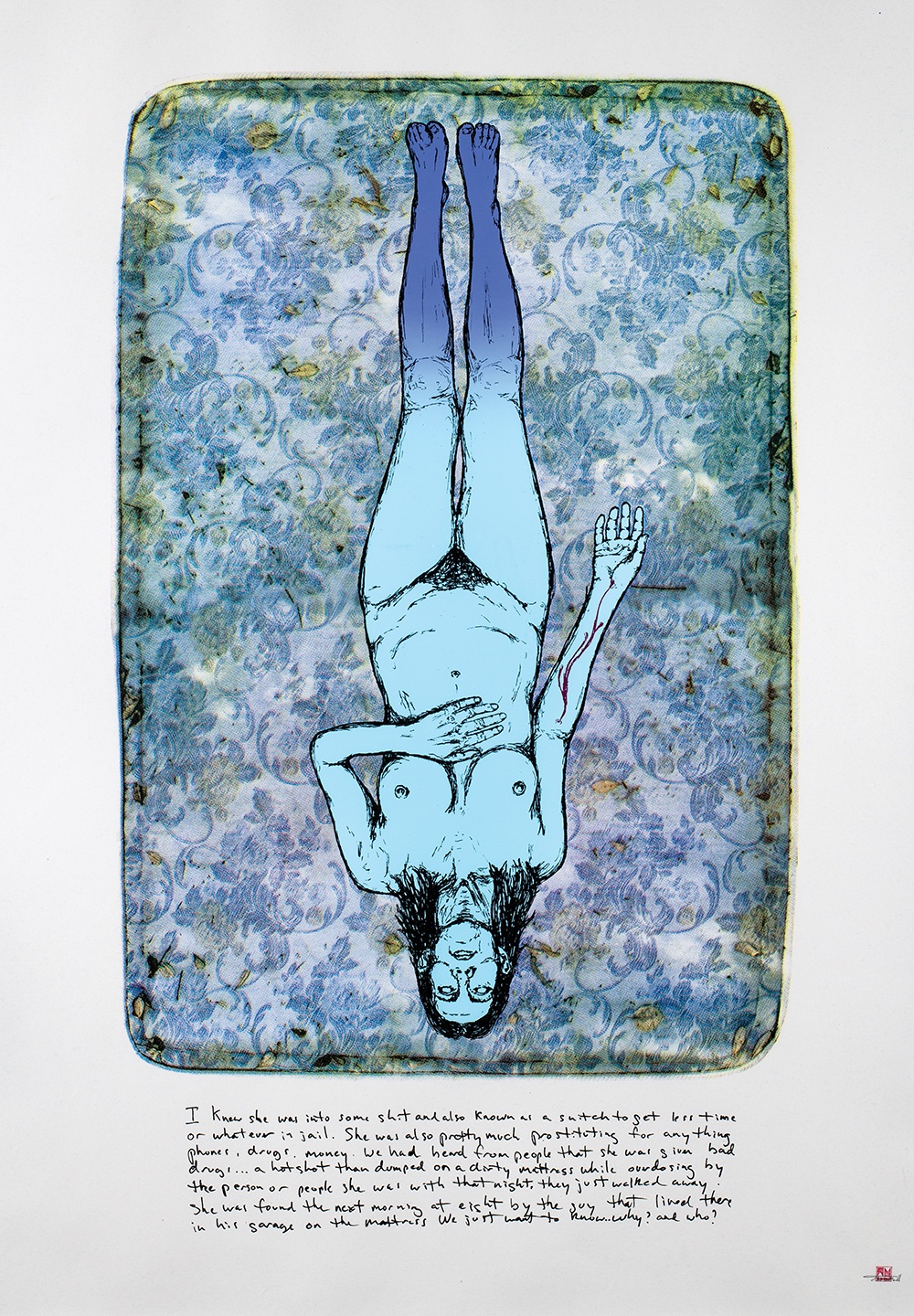Wilson professor uses his art to give meaning to tragedy and a voice to victims.
By Darrach Dolan
Adam DelMarcelle, Wilson’s visiting associate professor of graphic design, sports a full beard greying around the edges, wears a baseball cap and a camo sweat-shirt, and greets visitors with a boyish smile. Yet this friendly and easy-going man has “hacked” the Metropolitan Museum of Art (Met) in New York City, made national news when he plastered his hometown of Lebanon, Pa., with posters depicting scenes from the drug epidemic, projected images onto Amish barns and corporate headquarters, and has his work collected by the Library of Congress. Despite his laidback appearance, DelMarcelle is driven and passionate. Not only does he produce his own art at quite a clip, exhibit it across the country, and collaborate with other artists, he teaches graphic design, art history, and photography and works with practicing artists in our Master of Fine Arts program.
As a teacher, he provides his students with the technical skills to succeed as graphic designers, photographers, communicators, and artists. He sees his role as more than helping them find meaningful careers; he wants to help them grow as people. “My aim is to mentor ethical artists and designers,” he said. He encourages them “to use their knowledge as visual communicators to construct a more just world. [And I try to show them] that they can challenge the status quo and be the change they seek in the world … to not have hope but to be a hope. I am honored to work with the students at Wilson College.
”Not surprisingly, his artistic and teaching philosophies overlap. “I’m a social artist,” he explained. “I don’t like to use the word activist. I see myself as an activated member of my community. You try to have a lasting impact on your community.” He makes it clear that he does not have the answers or solutions to the issues on which he shines his artistic spotlight. Art, he believes, seeks to pose the right questions rather than dictate the answers. As he put it, “If you get a person to ask a question about the world, that’s a win. If you get a person to ask a question about themselves, that’s a home run. That allows them to take something back to the world with them.”
However, DelMarcelle’s journey to tremendous artistic output and giving back to his community is the result of great loss and personal tragedy.
After high school, he went to art school but dropped out after a couple of years. He then worked for 15 years as a crisis counselor at a hospital working with individuals and families with mental health, drug, and other issues. While there, he went back to art school and completed a bachelor’s and a master’s in visual art. But he wasn’t producing much of his own work. Instead, he satisfied his artistic needs by running a screen-printing press on the side that made prints for other local artists.
Then, in 2013, he noticed a dramatic uptick in the number of people arriving at the hospital having overdosed on opioids. Overdoses had been rare, deaths even rarer, but suddenly, on any given weekend in his small-town hospital, four or five people were dying of overdoses. Yet no one was talking about it, and it wasn’t making the news. It was as if no one cared enough about the deaths of “drug addicts” to even ask what was happening.
As it turns out, DelMarcelle was witnessing the first wave of the “opioid epidemic” hitting his hometown. The same tragedy was playing out across America and often in small or medium-sized towns rather than the large metropolitan areas associated with past drug epidemics. According to the CDC, opioid overdoses killed more than 400,000 Americans between 1999 and 2017. Little did he realize that the epidemic was about to affect him even more personally.
On Sept. 19, 2014, DelMarcelle went home and found his brother Joey dead of a heroin overdose.
He and his family were devastated. They had no idea Joey was doing heroin, let alone may have been addicted to the drug. “If you saw him, you’d never guess,” DelMarcelle said. “He was the epitome of fitness, a social worker, the sort of person you would call if you were in trouble, the very sort of person you wouldn’t associate with substance use.”
If Joey’s death was searingly painful, the family’s treatment by the police and authorities made things worse. They regarded his death as just one more junkie dying and, according to DelMarcelle, didn’t see much point in investigating it. They spoke of Joey as an “addict” and his death as predictable. DelMarcelle had overheard this type of disregard for overdose many times at the hospital and was dismayed to be on the receiving end of such callousness. He was enraged.
“After he died, I stopped making prints for other artists and started staying up at night reading about overdoses and what happens to people and about the drug war. I needed answers to the questions [Joey] couldn’t answer anymore,” he said. When he wasn’t researching the subject, he began making his own prints depicting scenes of overdose deaths, the victims, and the authorities’ indifference. He cranked them out by the dozens on his manual press. “[Printing is] a physical act, and I’d do it until my arm was too tired to keep going. I would have stacks and stacks of them, and that’s how I dealt with my grief. On the second anniversary of his death, I hung a thousand prints around my town to commemorate.”
His act of remembrance for his brother had a surprising effect: People started talking about the overdoses. On the third day, the mayor ordered the police to tear the prints down, citing an ordinance against hanging anything from utility poles (they didn’t tear down the posters that other people had put up). DelMarcelle put another thousand up. They were torn down too. He then plastered prints over the entire front of a building owned by a relative. Even though this was private property and the prints were put up with the permission of the owner, they were torn down as well.
His prints may have disappeared, but his campaign had already reached a lot of people. The media took notice, and the subject of overdoses, opioids, and the authorities’ response was in the spotlight in a way it hadn’t been before. Even more surprising to DelMarcelle, the Library of Congress asked for copies of his prints for their collection. He realized his art had the power to reach others and, he hoped might even foster change.
DelMarcelle knew he had found his subject, or his subject had found him, and has dedicated himself to using art to tell the stories of the lives affected by the opioid epidemic. He got funding to buy a theater projector and can now project his images onto buildings without fear of the police tearing them down. As his fame grew, so did the demand to exhibit his work. Unlike many artists, he doesn’t charge institutions and galleries to show his work. Instead, he requires them to include education or outreach about the drug epidemic to accompany the show. For example, local groups who support safe needle exchanges or harm reduction strategies could have stands or information booths alongside his work.
More recently, he worked with collaborators to “virtually hack” the Met. The Sackler Wing of the museum was, as the name suggests, funded by the Sackler family. The family owns Purdue Pharma, which created OxyContin — an opioid many consider the drug that started today’s opioid crisis. DelMarcelle and his collaborators wanted a way to expose how institutions like the Met were more than willing to take money from individuals or companies responsible for great harm and turn a blind eye to how the money was made.
They used augmented reality (AR) to superimpose the story of the opioid crisis through the life and death of one of its young victims on Met exhibits. It works like this: you download the Mariah App onto your smartphone, then, when you visit the Sackler Wing of the Met and point your phone at the exhibits, you see and hear an alternative narrative. Instead of learning about the mummies and artifacts from ancient Egypt, you learn about Mariah Lotti, who was addicted to opioids and died of an overdose at the age of 19. As you tour the wing and point your phone at different artifacts, you learn about other victims of the epidemic as well as the connections between the crisis and the Sacklers.
Interestingly, the Met recently decided to remove the Sackler name from the wing and other spaces in response to the public outrage at the role Purdue Pharma played in the crisis.
When he first began making art about the opioid crisis and those affected by it, he was angry. He wanted and expected the police to kick down doors and pursue the dealer who had sold Joey the drugs that killed him. He wanted revenge. He wanted action against dealers and suppliers. He was a brother who had lost a brother and wanted heads to roll. Today his attitude is more nuanced. He sees the opioid crisis as part of a bigger and more complicated picture of drugs and society. “If you asked me seven years ago about safe injection sites, I would have said it would be the downfall of society,” he said. “Now I’m a big advocate for them.” He believes harm reduction is more effective than long prison sentences and the criminalization of drug users. If you provide safe environments for people to take drugs, clean needles, outreach, information, you can help keep people alive until such time as they are ready to try treatment options.
In the years since his brother’s death, he has produced many images of people who have died of overdoses. These images are important as memorials to the victims, but they are also ways of humanizing them. He wants his audiences to see the victims as real people just like his brother or Mariah, people with potential and families that loved them, people who could have contributed to society and lived long, productive lives. These positive images are in direct contrast to the images in mainstream media of disease-ravaged criminals who will do anything for their drugs. He points out that both Joey and Mariah are more typical faces of substance use disorder — young, apparently healthy, and not criminal. He argues that it’s easy for legislators to dismiss funding for drug rehabilitation and other interventions if the victims are depicted as depraved, criminal, or marginalized.
Similarly, he believes the language we use to describe the drug crisis is important. “I was talking about addicts and addiction when I first started this,” he said. But he now uses different words, again to humanize the victims and to remove some of the stigma. Instead of being addicts or drug abusers, they are people who suffer from a substance use disorder. And he points out that they are often regular members of society holding down jobs, rearing children, contributing to their communities. They are siblings, friends, and neighbors, not criminal drug fiends. “If you can do one thing, don’t use addict in your vocabulary,” he said. “Small changes can lead to bigger changes.”
DelMarcelle continues to produce work and advocate for the victims of the crisis. He is collaborating with an art icon from an earlier epidemic — the AIDS epidemic. Eric Avery is a doctor, psychiatrist, and artist who worked on the frontlines of that crisis and produced woodcuts depicting the suffering and strength of his contemporaries in the face of AIDS. Together, Avery and DelMarcelle have put together an exhibition entitled “Epidemic” that is touring the country and features works juxtaposing scenes from both epidemics.
DelMarcelle’s success and growing reputation are bittersweet. He is happy his work reaches others and helps foster understanding of the drugs crisis, but the motivation and original impetus has not lost any of its associated pain. “I work nonstop because I’m scared of stopping and having to face the fact my family has lost some-one to opioids,” he said.







